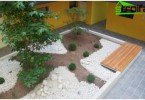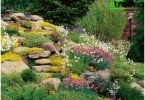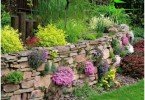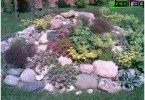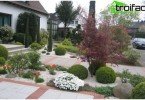How to make a rutaria site
The fact that a personal plot can be transformed with the help of vegetation is well known even to novice gardeners. But how to turn it into a cozy and unusual corner with the help of improvised means – roots and snags, such a science is worth learning from. A kindergarten made of such materials has an interesting name – rutarium. Let’s find out what secrets will help to equip it in the country.
Content
- What does rutarium start with?
- We search and process materials for the root garden
- Choose the type of rutaria and think over the main idea of composition
- We study the “golden” rules for creating a spectacular rutaria
What does rutarium start with?
In modern landscape design, such a concept as rutarium appeared relatively recently. This way of designing the site came to taste first to the inhabitants of European countries. It all started with the fact that some gardener came up with to decorate his territory with the help of a composition of roots, snags, hemp. Gradually, his fame spread throughout the world, and Russia was no exception.
Sometimes the decision to create a composition from natural materials arises spontaneously. For example, a dried-up branch of an intricate shape or a stump that resembles a fairy-tale character has turned up by your arm. Then I want to fit them into the landscape, connecting my imagination and imagination.
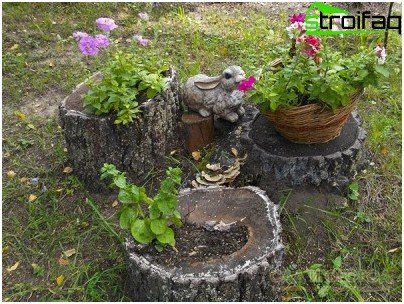
Creating a composition, you need to make sure that it looks voluminous, and its different parts are in harmony
However, amateur gardeners should be aware that the rutarium in the photo will look really impressive if you follow certain rules when creating it. Given specific recommendations, you can create a very intricate and cute corner in your country house. Let’s learn this together.
To begin with, we will find a place to locate the rutarium. Stumps and driftwood in the garden should look like a harmonious continuation of the landscape. Before you compose a composition, you need to imagine whether it fits well into the surrounding landscape. For example, sometimes the best place for her is right at the entrance to the cottage, where she will meet each of your guests. In some cases, you can make the territory mysterious if you place driftwood that are so similar to fairy-tale characters or unusual animals in remote darkened corners..
We search and process materials for the root garden
Work on the kindergarten begins with the search for suitable materials. To do this, you can walk through your own personal territory. What is useful to us for registration of rutaria? An excellent basis for the composition will be the branches that remain after pruning fruit trees. If on your site there is such a rarity as an old mossy stump, then do not rush to uproot it! Perhaps he will become the central figure.
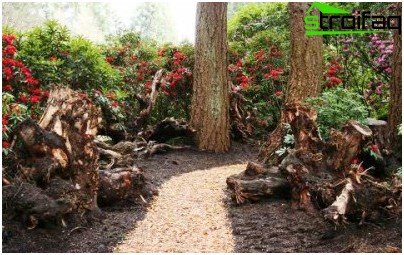
Working on rutarium, we essentially create a certain mood in our garden. The composition can be tuned to a soulful mood or invigorate, evoke memories or inspire new exploits
If you don’t have such materials at your fingertips, you can take a walk in the neighboring forest or park. Feel free to collect driftwood and the remains of stumps, large branches and pieces of bark. If you wish, you can even drag logs to the country, if you raise them by force. Sometimes such a good find as an intricate stump comes across.
Having collected the materials, it is necessary to prepare them correctly before making a composition out of them. Dry wood is best preserved if it is cleaned of dirt and moss, washed, and then dried. After that, it is varnished or impregnated with special means that will extend its lifespan by more than a dozen years. However, even without processing the branches or driftwood are able to please the eye for a rather long time – for 6-7 years. And since some of them are attractive precisely because of mossiness, you can leave them in their original form, only by eliminating dust and insects.
Choose the type of rutaria and think over the main idea of composition
So the most interesting stage of work has come – we need to think about which kindergarten to create and what its idea will be.
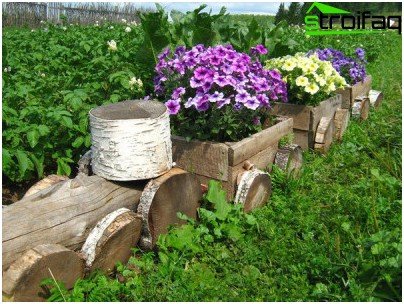
One of the indisputable advantages of rutaria is that it will always look original: in nature you cannot find two identical stumps or snags. Therefore, even the same idea will be presented in its own way, and the composition will not become similar to any of those seen earlier
The garden of roots and snags can be of three types. The first of them is called natural. This means that to create it, you can use both obsolete tree remnants and living vegetation. Such a decision is considered the most beautiful, because in such a composition dry branches, stumps and the original form of the root are perfectly intertwined with flowering ornamental plants..
The second option is the simplest kindergarten, in which only driftwood and stumps are involved. Of course, you need to work on them, for example, to give the stump the look of an old man, a forest man or another character. In essence, it is about creating a sculpture, which then needs to be entered into the landscape.
Finally, you can create the so-called decorative rutaria. This means that a dry tree and figures from it will play a key role in it, but living vegetation will surround it..
Having chosen the direction in which you will act, you need to come up with the main idea of your composition. For example, if children are frequent guests at your dacha, then you can use fabulous motives in the kindergarten. For lovers of philosophizing in the bosom of nature, a mysterious composition that inspires thoughts about the mortality of being and the meaning of life will be a more suitable option..
We study the “golden” rules for creating a spectacular rutaria
Moving from theory to practice and starting to put your idea into practice, it is necessary to consider several important recommendations. They will help create a lovely corner that will look beautiful and harmonious..
The first rule says that the more live vegetation is used in the composition, the more cheerful it will look. Therefore, as if I would not like to use all the unusual and original dry branches and roots, they must be used in moderation so that the kindergarten does not turn out to be joyless. It is best to select a few spectacular snags, and throw out the rest with an unwavering hand.
The second rule sounds like this – do not limit your imagination to using exclusively wood materials. If a great idea has ripened in your head, but only snags or stumps for its implementation is not enough, then pick up other improvised tools. For example, in gardening, any garden decor, pebbles, pieces of natural or artificial stone, forging elements and ceramic products will be appropriate.
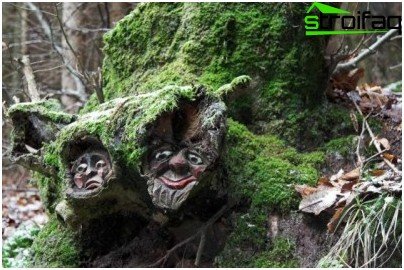
If you have the talent of an artist, then boldly apply it in a garden of roots. After all, any branch, snag or stump can give an interesting image
Finally, the third rule concerns the choice of vegetation, which will most harmoniously fit into the composition. It is believed that those plants that do not differ in particular splendor look best. For example, chamomiles and periwinkles, cornflowers and phloxes, petunias and black manes will perfectly play the woody figure. Ivy and fern will make your garden picturesque. By the way, no one bothers from year to year to bring something new to the composition, changing the vegetation. Then the garden of roots and snags will become a real attraction, which your loved ones and friends will enjoy.


